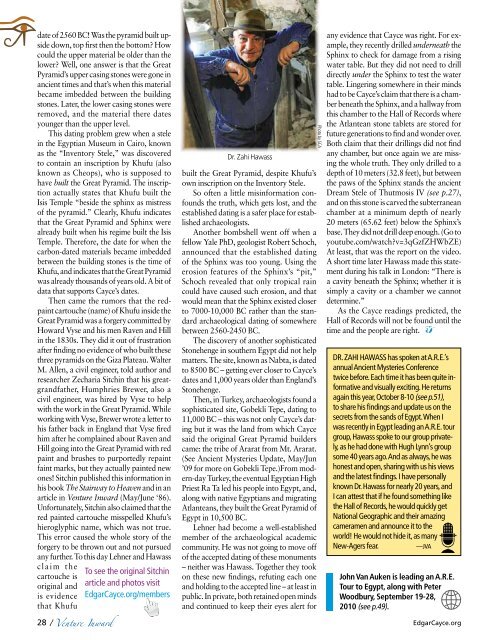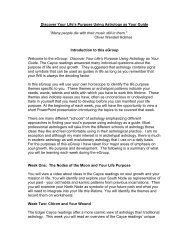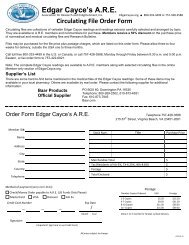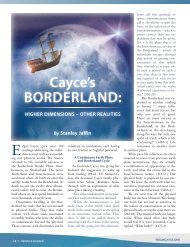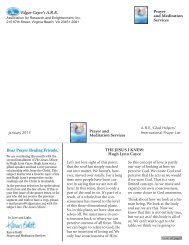new this issue - Edgar Cayce
new this issue - Edgar Cayce
new this issue - Edgar Cayce
Create successful ePaper yourself
Turn your PDF publications into a flip-book with our unique Google optimized e-Paper software.
date of 2560 BC! Was the pyramid built upsidedown, top first then the bottom? Howcould the upper material be older than thelower? Well, one answer is that the GreatPyramid’s upper casing stones were gone inancient times and that’s when <strong>this</strong> materialbecame imbedded between the buildingstones. Later, the lower casing stones wereremoved, and the material there datesyounger than the upper level.This dating problem grew when a stelein the Egyptian Museum in Cairo, knownas the “Inventory Stele,” was discoveredto contain an inscription by Khufu (alsoknown as Cheops), who is supposed tohave built the Great Pyramid. The inscriptionactually states that Khufu built theIsis Temple “beside the sphinx as mistressof the pyramid.” Clearly, Khufu indicatesthat the Great Pyramid and Sphinx werealready built when his regime built the IsisTemple. Therefore, the date for when thecarbon-dated materials became imbeddedbetween the building stones is the time ofKhufu, and indicates that the Great Pyramidwas already thousands of years old. A bit ofdata that supports <strong>Cayce</strong>’s dates.Then came the rumors that the redpaintcartouche (name) of Khufu inside theGreat Pyramid was a forgery committed byHoward Vyse and his men Raven and Hillin the 1830s. They did it out of frustrationafter finding no evidence of who built thesethree pyramids on the Giza Plateau. WalterM. Allen, a civil engineer, told author andresearcher Zecharia Sitchin that his greatgrandfather,Humphries Brewer, also acivil engineer, was hired by Vyse to helpwith the work in the Great Pyramid. Whileworking with Vyse, Brewer wrote a letter tohis father back in England that Vyse firedhim after he complained about Raven andHill going into the Great Pyramid with redpaint and brushes to purportedly repaintfaint marks, but they actually painted <strong>new</strong>ones! Sitchin published <strong>this</strong> information inhis book The Stairway to Heaven and in anarticle in Venture Inward (May/June ‘86).Unfortunately, Sitchin also claimed that thered painted cartouche misspelled Khufu’shieroglyphic name, which was not true.This error caused the whole story of theforgery to be thrown out and not pursuedany further. To <strong>this</strong> day Lehner and Hawassc l a i m t h ecartouche isoriginal andis evidencethat KhufuTo see the original Sitchinarticle and photos visit<strong>Edgar</strong><strong>Cayce</strong>.org/membersDr. Zahi Hawassbuilt the Great Pyramid, despite Khufu’sown inscription on the Inventory Stele.So often a little misinformation confoundsthe truth, which gets lost, and theestablished dating is a safer place for establishedarchaeologists.Another bombshell went off when afellow Yale PhD, geologist Robert Schoch,announced that the established datingof the Sphinx was too young. Using theerosion features of the Sphinx’s “pit,”Schoch revealed that only tropical raincould have caused such erosion, and thatwould mean that the Sphinx existed closerto 7000-10,000 BC rather than the standardarchaeological dating of somewherebetween 2560-2450 BC.The discovery of another sophisticatedStonehenge in southern Egypt did not helpmatters. The site, known as Nabta, is datedto 8500 BC – getting ever closer to <strong>Cayce</strong>’sdates and 1,000 years older than England’sStonehenge.Then, in Turkey, archaeologists found asophisticated site, Gobekli Tepe, dating to11,000 BC – <strong>this</strong> was not only <strong>Cayce</strong>’s datingbut it was the land from which <strong>Cayce</strong>said the original Great Pyramid builderscame: the tribe of Ararat from Mt. Ararat.(See Ancient Mysteries Update, May/Jun’09 for more on Gobekli Tepe.)From modern-dayTurkey, the eventual Egyptian HighPriest Ra Ta led his people into Egypt, and,along with native Egyptians and migratingAtlanteans, they built the Great Pyramid ofEgypt in 10,500 BC.Lehner had become a well-establishedmember of the archaeological academiccommunity. He was not going to move offof the accepted dating of these monuments– neither was Hawass. Together they tookon these <strong>new</strong> findings, refuting each oneand holding to the accepted line – at least inpublic. In private, both retained open mindsand continued to keep their eyes alert forDr. Zahi Hawass has spoken at A.R.E.’sannual Ancient Mysteries Conferencetwice before. Each time it has been quite informativeand visually exciting. He returnsagain <strong>this</strong> year, October 8-10 (see p.51),to share his findings and update us on thesecrets from the sands of Egypt. When Iwas recently in Egypt leading an A.R.E. tourgroup, Hawass spoke to our group privately,as he had done with Hugh Lynn’s groupsome 40 years ago. And as always, he washonest and open, sharing with us his viewsand the latest findings. I have personallyknown Dr. Hawass for nearly 20 years, andI can attest that if he found something likethe Hall of Records, he would quickly getNational Geographic and their amazingcameramen and announce it to theworld! He would not hide it, as manyNew-Agers fear.—JVAJohn Van Auken is leading an A.R.E.Tour to Egypt, along with PeterWoodbury, September 19-28,2010 (see p.49).c28 7 <strong>Edgar</strong><strong>Cayce</strong>.orgPhoto by SCAany evidence that <strong>Cayce</strong> was right. For example,they recently drilled underneath theSphinx to check for damage from a risingwater table. But they did not need to drilldirectly under the Sphinx to test the watertable. Lingering somewhere in their mindshad to be <strong>Cayce</strong>’s claim that there is a chamberbeneath the Sphinx, and a hallway from<strong>this</strong> chamber to the Hall of Records wherethe Atlantean stone tablets are stored forfuture generations to find and wonder over.Both claim that their drillings did not findany chamber, but once again we are missingthe whole truth. They only drilled to adepth of 10 meters (32.8 feet), but betweenthe paws of the Sphinx stands the ancientDream Stele of Thutmosis IV (see p.27),and on <strong>this</strong> stone is carved the subterraneanchamber at a minimum depth of nearly20 meters (65.62 feet) below the Sphinx’sbase. They did not drill deep enough. (Go toyoutube.com/watch?v=3qGzfZHWbZE)At least, that was the report on the video.A short time later Hawass made <strong>this</strong> statementduring his talk in London: “There isa cavity beneath the Sphinx; whether it issimply a cavity or a chamber we cannotdetermine.”As the <strong>Cayce</strong> readings predicted, theHall of Records will not be found until thetime and the people are right.


